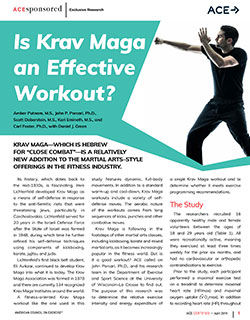
Amber Putnam, M.S., John P. Porcari, Ph.D., Scott Doberstein, M.S., Kari Emineth, M.S., and Carl Foster, Ph.D., with Daniel J. Green
Krav Maga—which is Hebrew for “close combat”—is a relatively new addition to the martial arts–style offerings in the fitness industry. Its history, which dates back to the mid-1930s, is fascinating. Imre Lichtenfeld developed Krav Maga as a means of self-defense in response to the anti-Semitic riots that were threatening Jews, particularly in Czechoslovakia. Lichtenfeld served for 20 years in the Israeli Defense Force after the State of Israel was formed in 1948, during which time he further refined his self-defense techniques using components of kickboxing, karate, jujitsu and judo.
Lichtenfeld’s first black belt student, Eli Avikzar, continued to develop Krav Maga into what it is today. The Krav Maga Association was formed in 1978 and there are currently 134 recognized Krav Maga Institutes around the world.
A fitness-oriented Krav Maga workout like the one used in this study features dynamic, full-body movements. In addition to a standard warm-up and cool-down, Krav Maga workouts include a variety of self-defense moves. The aerobic nature of the workouts comes from long sequences of kicks, punches and other combative moves.
Krav Maga is following in the footsteps of other martial arts classes, including kickboxing, karate and mixed martial arts, as it becomes increasingly popular in the fitness world. But is it a good workout? ACE called on John Porcari, Ph.D., and his research team in the Department of Exercise and Sport Science at the University of Wisconsin–La Crosse to find out. The purpose of this research was to determine the relative exercise intensity and energy expenditure of a single Krav Maga workout and to determine whether it meets exercise programming recommendations.
The Study
The researchers recruited 16 apparently healthy male and female volunteers between the ages of 18 and 29 years old (Table 1). All were recreationally active, meaning they exercised at least three times weekly for the prior six months and had no cardiovascular or orthopedic contraindications to exercise.
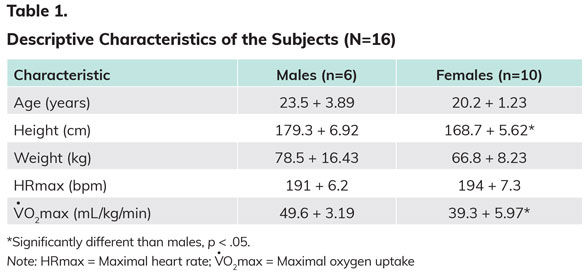
Prior to the study, each participant performed a maximal exercise test on a treadmill to determine maximal heart rate (HRmax) and maximal oxygen uptake (VO2max). In addition to recording heart rate (HR) throughout the test, the researchers collected ratings of perceived exertion (RPE) every two minutes.
Each participant performed at least two practice sessions to become familiar with the Krav Maga workout. Once the research team deemed them to be proficient, the participants completed a 60-minute Krav Maga workout session by following along to a pre-recorded DVD. Heart rate was recorded each minute during the workout and RPE was assessed every five minutes. Finally, the HR values were inserted into individual HR/VO2 regression equations (as determined during the maximal exercise test) to predict VO2 on a minute-by-minute basis during the Krav Maga session.
The Results
The physiological responses to the Krav Maga session are summarized in Table 2. As you can see, there were no significant differences in HR, RPE, %HRmax or %VO2max between males and females, though males achieved significantly higher VO2 and metabolic equivalents (METs) during the workout and expended significantly more calories than the females.
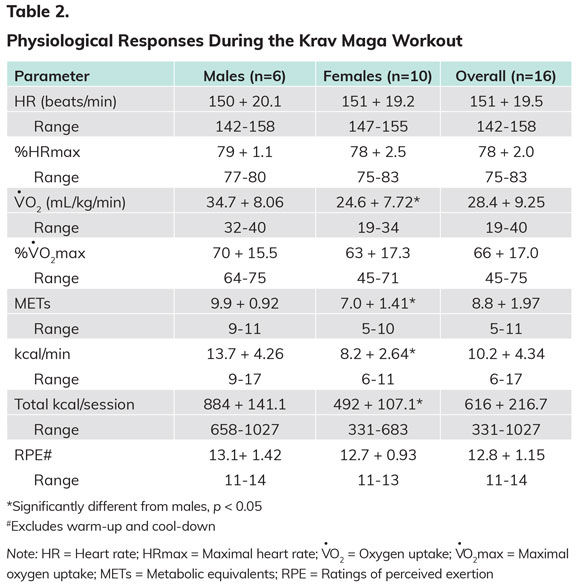
Exercise intensity data are also graphically presented in Figures 1 through 3. The research team represented the intensity in terms of %HRmax and %VO2max, as that is how it is most often represented in the comparative literature.
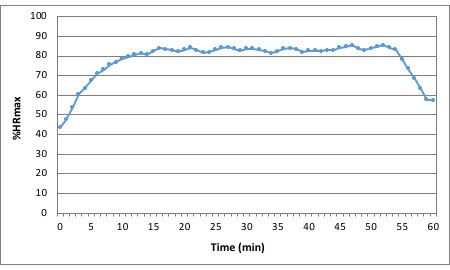
Figure 1. Relative HR responses (% HRmax) during the Krav Maga workout. The boxed region indicates the ACSM guidelines for improving cardiorespiratory endurance (64-76% of HRmax corresponds to moderate intensity and 77-95% of HRmax corresponds to vigorous intensity).
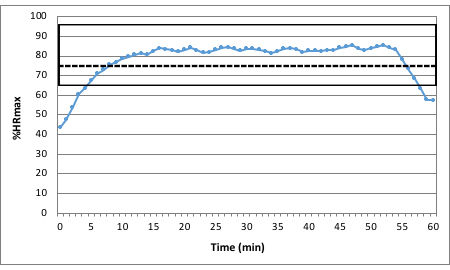
Figure 2. Relative oxygen consumption responses (%VO2max) during the Krav Maga workout. The boxed region indicates the ACSM guidelines for improving cardiorespiratory endurance (46-63% of VO2max corresponds to moderate intensity and 65-90% of VO2max corresponds to vigorous intensity).

Figure 3. Rating of perceived exertion (RPE) response during the Krav Maga workout
The Bottom Line
The purpose of this study was to determine the relative exercise intensity and energy expenditure of a Krav Maga session and to compare those values to guidelines for improving cardiorespiratory endurance and for weight management [American College of Sports Medicine (ACSM), 2018].
ACSM (2018) recommends that individuals exercise between 64 and 95% of HRmax or 46 and 90% of VO2max to improve cardiorespiratory endurance. In this study, exercise intensity averaged 78% of HRmax and 66% of VO2max, which places it on the borderline between the moderate- and vigorous-intensity ranges. It should be noted that these averages included the five-minute warm-up and five-minute cool-down.
As shown in Figures 1 and 2, the participants were exercising in the vigorous-intensity range for the majority of the workout portion of the Krav Maga session. This is similar to findings on research on other martial arts (Hausen et al., 2017; Buermann et al., 2012; Milanez et al., 2012; Bridge et al., 2007; Imamura et al., 1999; Francescato, Talon and Di Prampero, 1995). Similarly, the average MET requirement for the Krav Maga session was 8.8 METs, which falls into the vigorous-intensity range. This is slightly more intense than running at 5 mph or bicycling at 13 mph.
In terms of caloric expenditure, it is recommended that people expend between 1,200 and 2,000 calories per week during exercise, or 240 to 400 calories per exercise session (assuming five sessions per week) to positively affect body composition (Donnelly et al., 2009). The participants in this study burned an average of 616 calories during the one-hour Krav Maga session, placing it well above that recommended range.
Finally, the researchers looked at RPE for all participants, which fell in a range of 11 to 14 and would classify Krav Maga as a moderate-intensity activity.
Overall, the results of this study indicate that the Krav Maga workout used in the study met ACSM guidelines for improving cardiorespiratory fitness and managing body weight. The HR, VO2 and RPE measurements all indicate that exercisers can expect a moderate-to-vigorous intensity workout that teaches self-defense techniques while simultaneously providing a full-body workout. Importantly, Dr. Porcari reports that the participants really liked the workouts, saying that they found it a fun way challenge themselves.
References
American College of Sports Medicine (2018). ACSM’s Guidelines for Exercise Testing and Testing and Prescription (10th ed.). Philadelphia: Wolters Kluwer.
Bridge, C. et al. (2007). Heart rate responses to taekwondo training in experienced practitioners. Journal of Strength and Conditioning Research, 21, 3, 718–723.
Buermann, M. et al. (2012). Can you QiDance your way to fitness? Journal of Sports Science and Medicine, 11, 771–772.
Donnelly, J. et al. (2009). Appropriate physical activity intervention strategies for weight loss and prevention of weight regain for adults. Medicine & Science in Sports & Exercise, 41, 459–471. DOI: 10.1249/MSS.0b013e3181949333
Francescato, M.P., Talon, T. & Di Prampero P.E. (1995). Energy cost and energy sources in karate. European Journal of Applied Physiology, 71, 355–361.
Hausen, M. et al. (2017). Physiological responses and external validity of a new setting for taekwondo combat simulation. PLoS ONE, 12, 2, 1–14. DOI:10.1371/journal.pone.0171553.
Imamura, H. et al. (1999). Oxygen uptake, heart rate, and blood lactate responses during and following karate training. Medicine & Science in Sports & Exercise, 31, 2, 342–347.
Milanez, V. et al. (2012). Heart rate response during a karate training session. RBME, 18, 1, 1–9.





 by
by 

